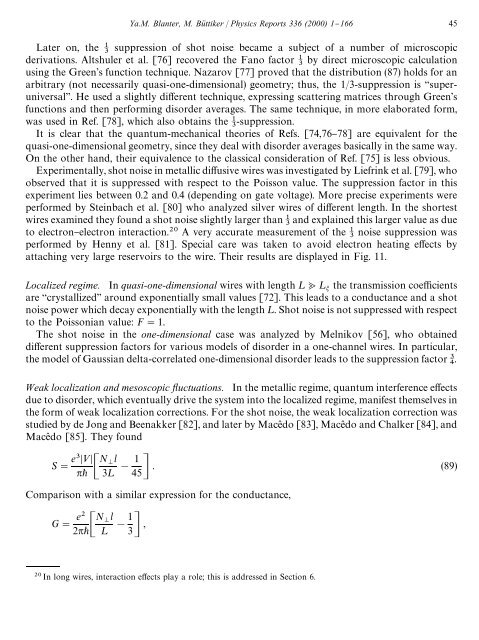shot noise in mesoscopic conductors - Low Temperature Laboratory
shot noise in mesoscopic conductors - Low Temperature Laboratory
shot noise in mesoscopic conductors - Low Temperature Laboratory
Create successful ePaper yourself
Turn your PDF publications into a flip-book with our unique Google optimized e-Paper software.
Ya.M. Blanter, M. Bu( ttiker / Physics Reports 336 (2000) 1}166 45<br />
Later on, the suppression of <strong>shot</strong> <strong>noise</strong> became a subject of a number of microscopic<br />
derivations. Altshuler et al. [76] recovered the Fano factor by direct microscopic calculation<br />
us<strong>in</strong>g the Green's function technique. Nazarov [77] proved that the distribution (87) holds for an<br />
arbitrary (not necessarily quasi-one-dimensional) geometry; thus, the 1/3-suppression is `superuniversala.<br />
He used a slightly di!erent technique, express<strong>in</strong>g scatter<strong>in</strong>g matrices through Green's<br />
functions and then perform<strong>in</strong>g disorder averages. The same technique, <strong>in</strong> more elaborated form,<br />
was used <strong>in</strong> Ref. [78], which also obta<strong>in</strong>s the -suppression.<br />
It is clear that the quantum-mechanical theories of Refs. [74,76}78] are equivalent for the<br />
quasi-one-dimensional geometry, s<strong>in</strong>ce they deal with disorder averages basically <strong>in</strong> the same way.<br />
On the other hand, their equivalence to the classical consideration of Ref. [75] is less obvious.<br />
Experimentally, <strong>shot</strong> <strong>noise</strong> <strong>in</strong> metallic di!usive wires was <strong>in</strong>vestigated by Liefr<strong>in</strong>k et al. [79], who<br />
observed that it is suppressed with respect to the Poisson value. The suppression factor <strong>in</strong> this<br />
experiment lies between 0.2 and 0.4 (depend<strong>in</strong>g on gate voltage). More precise experiments were<br />
performed by Ste<strong>in</strong>bach et al. [80] who analyzed silver wires of di!erent length. In the shortest<br />
wires exam<strong>in</strong>ed they found a <strong>shot</strong> <strong>noise</strong> slightly larger than and expla<strong>in</strong>ed this larger value as due<br />
to electron}electron <strong>in</strong>teraction. A very accurate measurement of the <strong>noise</strong> suppression was<br />
performed by Henny et al. [81]. Special care was taken to avoid electron heat<strong>in</strong>g e!ects by<br />
attach<strong>in</strong>g very large reservoirs to the wire. Their results are displayed <strong>in</strong> Fig. 11.<br />
Localized regime. In quasi-one-dimensional wires with length ¸
















